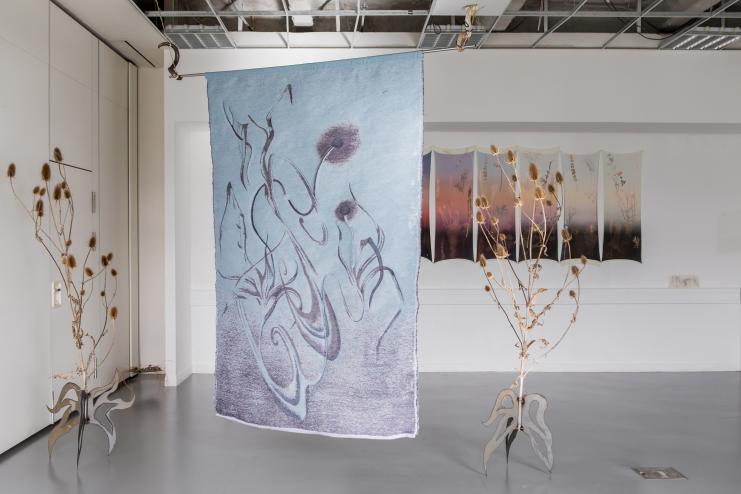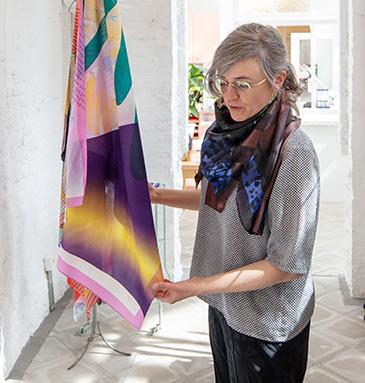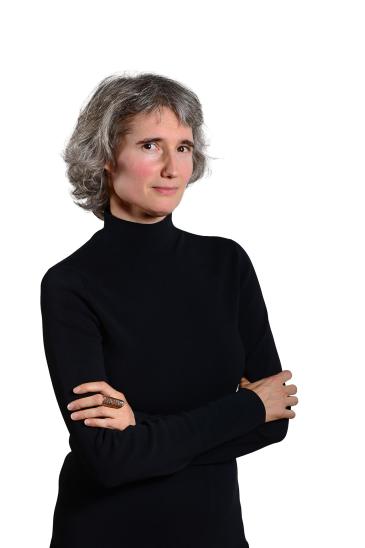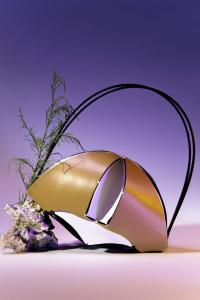Textile and Texture Design

The Textile and Texture Design department draws on creativity and research methods as well as on technical skills in order to train responsible and multi-skilled creators and designers. Mindful of the ecological and social issues raised by the production of materials, the department helps students take a critical look at our current systems, find solutions and aim for innovation, whether frugal or technological.
- Introducing the basics of textile: weaving, knitting, graphic design and textile printing;
- Absorbing design methods: mood board, mapping and building a project;
- Transforming material and graphic research into textile materials, whether soft or rigid
- Creating a first textile and texture alphabet;
- Knowing and identifying the various textile materials, from the most classic to the most innovative ones (Textile & technology / new materials);
- Experimenting with the basics of color: the interaction between color, graphic design and printing;
- A number of workshops and partnerships enable to cross-fertilize skills with other departments of the School;
- The culture of textile (history, visiting archives, collections and exhibitions, current events);
- Textile experiments workshops: Shibori, natural dies, Pointcarre textile software (for weaving).
- 1st semester: the syllabus alternately ponders on the practices of artistic direction and introduces new technical skills thanks to workshops. The PSL-week also enables the textile and texture designers to experiment with the practices of science and engineering, as part of an interdisciplinary course. Students may also choose to spend a semester abroad in a partner school.
- 2nd semester: discovering the methods and challenges of design and of research-based design, especially thanks to the “What do I know?” and the “Future materialities” classes. The latter deeply relies on a project dynamic and is most specifically built along with an academic or an industrial partner.
- Questioning the creative processes at stake in sustainable development may be at the heart of students’ projects. Students strive to provide solutions to create a more responsible world (regarding ecology, ethics, health, education..…).Some projects question our current or future lifestyles, reinvent the future, suggest new speculative scenarios of future applications and new ways of interacting with the world.
- Others focus on the production process: they experiment with the parameters of the creative process, from crafted to industrial skills, in order to find new creative solutions.
- Students may also explore poetic creative solutions to capture the collective psyche by adapting them to various uses and contexts.
- Once they have graduated, they establish their practices as freelance or salaried textile designers, color designers, color and texture designers or as visual artists.
About the course
Students learn to analyze both contexts and needs, to create tangible and coherent universes and to provide solutions using three cross-disciplinary media: material, color and drawing.
The material can be textile, but not only: it is also the one we touch, the one that surrounds everyday - our bodies, places, objects - the material which enables us to express both ideas and emotions. Handcrafted experiments and manual skills are thus just as important as the conceptualization process.
Mindful of the ecological and social issues raised by the production of materials, the department helps students take a critical look at our current systems, find solutions and aim for innovation, whether frugal or technological.
This course highlights those commitments through an introduction to design-based research.
Bachelor’s Degree
The 2nd and 3rd years are dedicated to learning the basics of textile and texture design.
2nd Year
From knowing the components of textiles and materials to innovatively using them while considering technical and industrial constraints, students are enabled to explore and learn how to express themselves through various media.
An interdisciplinary theme, which is developed in both the classes (graphic design, material, color) and the workshops (weaving, knitting, finishing), links personal expression with knowledge of the basics of textile.
The objectives are as follows:
3rd Year
The various projects and partnerships lead students towards autonomy. They also learn to meet precise design specifications and are introduced to various fields.
The aim of the 3rd year is to prepare the future graduates for professional life or for the Master’s degree. The exercises of the 2nd year thus focus on more concrete situations and on real-life contexts. They draw on exterior collaborations, which are supplemented by the internships students do during the summer.
The year’s exact syllabus is built in accordance with the School’s partnerships, which enable students to discover the various fields of textile, texture and color design.
As they become increasingly independent, the students keep on exploring generous productions thanks to the 3 textile workshops (ndr: lien vers 19 ateliers), which they have first discovered during the 2nd year. Students are more specifically expected to take into account the context and the constraints of the design requirements.
For the first time, they attend project follow-up meetings and are in contact with specialists in what is currently being done in the fashion, decoration and furniture fields.
This plunges students into a professional approach, through visits and meetings with professionals who give them an insight into the reality of the design world and into the various career pathways that already exist or that are yet to be built.
Regularly displaying their work to the public and to the partners is an integral part of the course.
As a closure to the year, students present and defend their work to a board of teachers who will determine whether they graduate.
Master’s Degree
The Textile and Texture Design Master’s degree trains students who are interested in current and future issues, who question their practices and identify as creators, so as to eventually create both personal and innovative projects.
4th Year
The 4th year focuses on the introduction to design-based research, on new technologies and innovative materials as well as on ecological issues. It is in line with a collective work dynamic. The aim is for students to eventually take new creative decisions autonomously and with a critical mind, in contexts which ponder on textiles practices.
The year ends with the “Kick-off” workshop, which is designed for students to think about and plan the beginnings of their Grand Projet.
Finally, a great number of studios(ndr: lien vers la page 19 ateliers) enable students to optionally supplement their course.
The thesis, which students begin at the end of the 3rd year, enables them to build personal thoughts on a particular issue. Students choose a thesis supervisor among the teachers of the École des Arts Décoratifs.
5th Year
The students develop their thinking through the practice of textile, material and surface design.
During that year, which is dedicated to conceptual and plastic creation, contemporary issues and personal imaginary worlds are intertwined, in order to create useful and original projects.
Students provide answers to a context and think about how their research could be used. Using the design methods and the technical skills they have learned, they create a set of works which combines innovation and creation.
The project may result in a collection of textiles which explores various techniques or which uses a specific skill. A wide range of fields is open to the students - clothing, performance, interior architecture, furniture, crafts, manufacturing..…
In order to conduct their research, students choose and identify a problem that they will elaborate on throughout the year. Thus, they must root their personal approach within a larger framework.
The problems may be centered around various notions:
If you want to know more about the latest news regarding the department and its students, follow our Instagram account: @ensad_paris_dtm
Teachers
| Nom | Fonction |
|---|---|
Lauriane Beaunier
Lauriane Beaunier
Diplômée de l'ENSAAMA et des Arts Décoratifs, en design textile, Lauriane Beaunier a tout d’abord travaillé dans l’industrie automobile puis dans le domaine de l’équipement de sport en tant que designer textile, couleur et matière. Elle a développé une capacité d'écoute et d'analyse qui nourrissent une approche transversale et décloisonnée du design, via la couleur, la matière et le graphisme. Cela l'amène à évoluer dans différents domaines, à différentes échelles, pour des clients français et internationaux : de l’objet au textile, de l’accessoire de mode aux matériaux décoratifs, l'espace et l’architecture d’intérieur, le territoire… C'est ainsi que l'étagère Pace qu'elle a dessiné avec le designer Aurélien Veyrat est rentrée dans les collections du Mobilier National en 2021 alors qu'elle était en train de concevoir avec lui 1000 m2 de bureaux pour Lille Grand Palais. Depuis, elle a été soutenue par le Ministère de la Culture dans le cadre de l'appel à projet Mondes Nouveaux, pour son projet Nuances littorales. |
Designer matière |
Aurélie Mossé
Aurélie Mossé
Aurélie Mosse, PhD, est une designer-chercheuse, professeure et consultante travaillant à l’intersection du design textile, de l’architecture et des nouvelles technologies. Co-responsable du groupe de recherche Soft Matters à l'École des Arts Déco depuis 2015, sa recherche explore comment matériaux actifs, vivants, induits par des bactéries, peuvent informer des perspectives d'habitation du monde plus poétiques et résilientes. Elle dirige ImpressioVivo (2021-26), 1er projet JCJC financé par l’Agence Nationale de la Recherche dans une école d’art, qui explore l’impression 3D de matériaux biosourcés et co-fabriqués avec des bactéries dans une optique de design circulaire. Bénéficiaire du réseau doctoral MSCA SOFTWEAR (2022-2026) dédié aux actionneurs souples et leur intégration dans le textile, elle est également membre du comité de pilotage du groupe d'intérêt spécial « Interdisciplinary Textiles Research » de la Design Research Society , et mène par ailleurs une réflexion sur les enjeux de transmissions transgénérationnelles, comme en témoigne son livre "L’accent fantôme et autres impressions séfarades" (2023). Publications : |
Designer, chercheuse, enseignante |
Maria Szakats
Maria SzakatsEnseignante. |
Non renseigné |
Orsina Visconti
Orsina ViscontiInformations
Enseignant·es
Designer textile et matière |
Designer textile et matière |
Mémoires
| Étudiant.e.s | Titre du Projet | Année |
|---|
